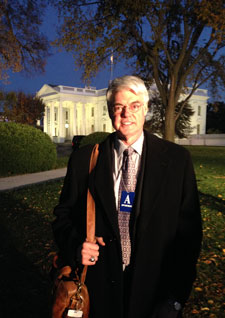Glotzbach to join education, business, government leaders at White House summit

President Philip A. Glotzbach
Joining other college presidents and leaders in business, government and philanthropy,
Skidmore President Philip A. Glotzbach will attend a full-day meeting being hosted
at the White House Thursday, Jan. 16, to explore how to increase opportunities for
low-income and disadvantaged students by scaling up the nation’s most successful approaches.
President Barack Obama, Michelle Obama, and Secretary of Education Arne Duncan will
participate, along with other senior officials. The event is scheduled from 9 a.m.
to noon and from 2 to 4 p.m. and will be livestreamed here.
Skidmore’s Opportunity Program—which traces its roots back to 1969—is regarded as
a national model, being among the first programs to place equal emphasis both on increasing
access and ensuring academic success through a rigorous pre-freshman experience and
a comprehensive advising program. Enrolling 40 low-income students per class—for a
total of 160 over all four classes—the College achieves graduation rates between 88
and 100 percent for these students, typically exceeding the 86 percent graduation
rate for Skidmore students generally.
In recent years, the College has expanded this effort by taking steps to ensure that
low-income students can take advantage of the full range of academic experiences that
Skidmore offers and establishing trajectories that launch them into successful careers
or top graduate schools upon earning their degrees. For example, Skidmore changed
its policies to ensure that financial aid awarded to low-income students can be used
to fund study abroad. The College also found a way to establish a new category of
grants that help students link academic interests with post-graduate goals by way
of an applied summer experience. Funded at $4000 each, these 20 “SEE-Beyond” awards
are sufficiently generous to appeal to low-income students who otherwise might feel
obligated to take summer jobs that have no connection to their academic studies or
career aspirations.
“Our goal is to offer within three to five years a SEE-Beyond experience to every
low-income student who would benefit from one,” said Glotzbach. “That will require
our doubling from 20 to 40 the number of SEE-Beyond stipends awarded.”
As part of its current 10-year strategic plan, Skidmore has more than doubled its
financial aid budget, which now exceeds $39 million annually and provides support
to more than 1,000 students. That investment has enabled the College to increase the
percentage of Pell-eligible students attending Skidmore from 15 percent to 17 percent.
It also has ensured that Skidmore students could graduate with manageable debt. Average
indebtedness for all Skidmore students who borrowed and graduated in 2012 was $22,753.
That compares in the same year to average indebtedness of $25,737 for New York public
and private colleges and universities and $27,850 for public and private colleges
and universities nationally.
“Higher education has long been an engine of both economic advancement and social
mobility in our country,” Glotzbach noted. “At Skidmore, we contribute actively to
this effort through our generous provision of need-based financial aid and strong
programs for academic support and mentorship. The seriousness of our commitment is
reflected by the diversity of our student body and our retention and graduation rates.”
He added, “I look forward to participating in the conversation at the White House
to discuss how the federal government might best partner with the higher education
community to advance this important agenda.”


